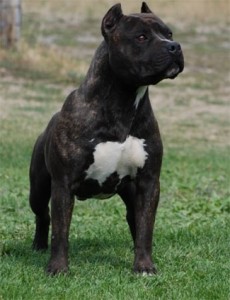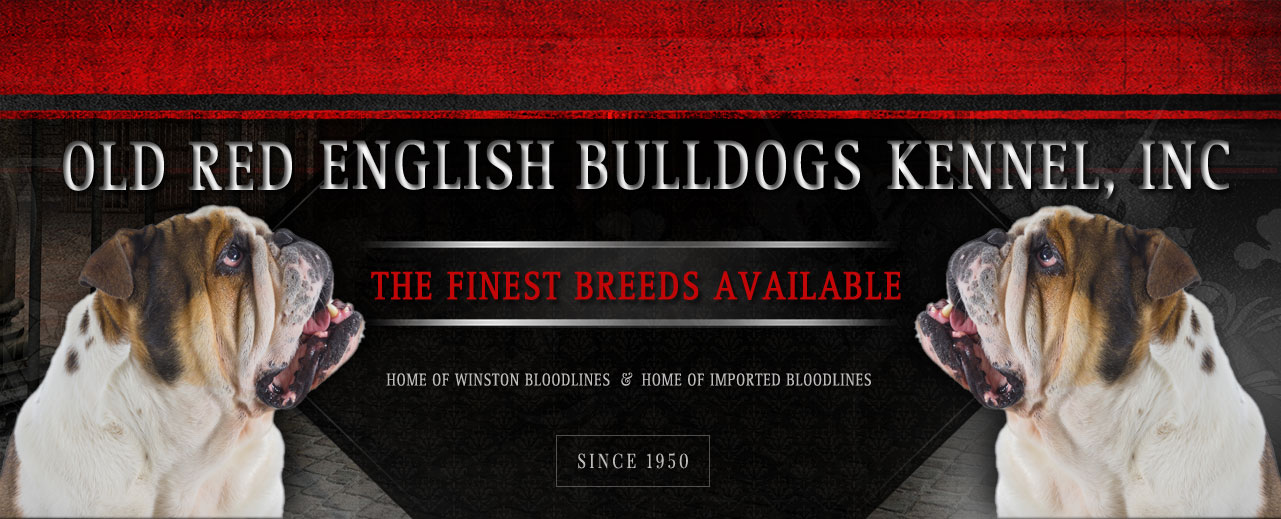 The American Staffordshire Terrier also known as Amstaff is a medium-sized, short-coated American dog breed. In the early part of the twentieth century the breed gained social stature and was accepted by the American Kennel Club as the American Staffordshire Terrier in 1936.[2] The name was changed to reflect difference from the Staffordshire Bull Terrier of England. Despite its name, the Staffordshire Terrier was first bred in the nineteenth century in Birmingham, West Midlands, rather than in the English county of Staffordshire where it was then later bred. The early ancestors of this breed came from England, where until the first part of the 19th century, the Bulldog was bred in England. Bulldogs pictured as late as 1870 resemble contemporary American Staffordshire Terriers to a greater degree than present-day Bulldogs. Some writers contend it was theWhite English Terrier,
The American Staffordshire Terrier also known as Amstaff is a medium-sized, short-coated American dog breed. In the early part of the twentieth century the breed gained social stature and was accepted by the American Kennel Club as the American Staffordshire Terrier in 1936.[2] The name was changed to reflect difference from the Staffordshire Bull Terrier of England. Despite its name, the Staffordshire Terrier was first bred in the nineteenth century in Birmingham, West Midlands, rather than in the English county of Staffordshire where it was then later bred. The early ancestors of this breed came from England, where until the first part of the 19th century, the Bulldog was bred in England. Bulldogs pictured as late as 1870 resemble contemporary American Staffordshire Terriers to a greater degree than present-day Bulldogs. Some writers contend it was theWhite English Terrier,
Fox Terrier, or the Black and Tan Terrier that was crossed with the Bulldog to develop the Staffordshire Terrier; all three breeds shared many traits, the greatest differences being in color, and spirit. The cross of Bulldog and Terrier was called by several names, including Bull-and-Terrier Dog, Pit Bull, or Half and Half.[3] Later, it assumed the name of Staffordshire Bull Terrier
GENERAL IMPRESSION
The American Staffordshire Terriers should give the impression of great strength for his size, a well put-together dog, muscular, but agile and graceful, keenly alive to his surroundings. He should be stocky, not long-legged or racy in outline. His courage is proverbial. Today, the American Staffordshire Terrier continues to demonstrate its versatility, competing successfully in Obedience, Tracking, Agility, Protection, and Weight Pulls, as well as Conformation.
HEAD – Medium length, deep through, broad skull, very pronounced cheek muscles, distinct stop; and ears are set high.
MUZZLE – Medium length, rounded on upper side to fall away abruptly below eyes. Jaws well defined. Underjaw to be strong and have biting power. Lips close and even, no looseness. Upper teeth to meet tightly outside lower teeth in front. Nose definitely black.
EYES – Dark and round, low down in skull and set far apart. No pink eyelids.
EARS – Cropped or uncropped, the latter preferred. Uncropped ears should be short and held rose or half prick. Full drop to be penalized.
NECK – Heavy, slightly arched, tapering from shoulders to back of skull. No looseness of skin. Medium length.
SHOULDERS – Strong and muscular with blades wide and sloping.
LEGS – The front legs should be straight, large or round bones, pastern upright. No semblance of bend in front. Hindquarters well-muscled, let down at hocks, turning neither in nor out. Feet of moderate size, well-arched and compact. Gait must be springy but without roll or pace.
BODY – Well-sprung ribs, deep in rear. All ribs close together. Forelegs set rather wide apart to permit chest development. Chest deep and broad.
BACK – Fairly short. Slight sloping from withers to rump with gentle short slope at rump to base of tail. Loins slightly tucked.
TAIL – Short in comparison to size, low set, tapering to a fine point; not curled or held over back. Not docked.
COAT – Short, close, stiff to the touch, and glossy.
COLOR – Any color, solid, parti, or patched is permissible, but all white, more than 80 per cent white, black and tan, and liver not to be encouraged. Not Merle.
SIZE – Height and weight should be in proportion. A height of about 18 to 19 inches at shoulders for the male and 17 to 18 inches for the female is to be considered preferable.
WEIGHT – Desirable weight for a mature male in good condition is between 70 and 100 pounds. Desirable weight for a mature female in good condition is between 65 and 95 pounds. Dogs over these weights are not to be penalized unless they are disproportionately massive or rangy.
FAULTS – Faults to be penalized are: Dudley nose, light or pink eyes, tail too long or badly carried, undershot or overshot mouths.
These are the Bulldogs and Mastiffs we breed and sell.
The pictures on each page are for identification purposes and OldBulldogs.com does not own every animal pictured. These pages are informational and intended to describe the standards of each breed.
- Alano Español
- Alapaha Blue Blood Bulldogs
- American Bandogge Mastiffs
- American Bully-Bullies
- American Pit Bull Terriers
- American Staffordshire Bullies
- American Staffordshire Terriers
- Arkansas Giant Bulldogs
- Australian Bandogge Mastiffs
- Australian Bulldogs
- American Bulldogs-Old Time Southern Bulldogs-Old Southern Whites
- Banter Bulldogs
- Boxer Bulldogs
- Bull Terriers
- Bull Mastiffs
- Miniature Bull Terriers
- Mexican Bulldogs
- Miniature English Bulldogs
- Neapolitan Mastiffs
- Old Boston Bulldogs
- Olde English Bulldogges
- Old Victorian Bulldogs
- Patterdale Terrier
- Perro de Presa Canario
- Performance-Standard Type American Bulldogs
- Perro de Presa Mallorquin
- Panja Mastiffs
- Renascence Bulldogs
- South African Boerboel
- Staffordshire Bull Terriers
- Saint Bernard
- Valley Bulldogs
- Winston Working Bulldogs
- Winston’s Working Mastiffs
- Winston’s Working Terriers
- Winston’s Working Hounds
- Winston’s Working Shepherds
